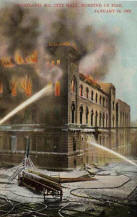
PFD History
(page2)
At that time, the Fire Chief was Melville N. Eldridge, and he was
appointed the City's first Permanent Chief of Department. Chief
Eldridge was well known for his organizational abilities and was
well respected throughout New England as a Fire Service leader. Upon
his appointment, he undertook
a major reorganization of the entire fire department which included; renumbering the Deering fire companies, assignments to box alarms, establishing first alarm response districts, disbanded three hose companies; Hose 10, Allen's Comer, Hose 13, Deering Center, and Hose 14, Libbytown. Five companies remained in the centralized neighborhoods; Hose 8-Ladder 4 at Woodford's Comer, Hose 9 at Morrill's Comer, Hose 11 at East Deering, and Hose 12 on Pitt Street in the Oakdale area. Permanent Drivers were then appointed and horses were purchased. A new hose wagon was assigned to Hose 11 and a spare ladder carriage was reconditioned to replace the Deering ladder truck, which was deemed too light for fire duty, and given to the city of South Portland.
The Peninsula was assigned as District- I and the Deering area as District-2.Upgrades were also made in the District-I area, including the purchase of Munjoy Hill's first ladder truck and the overall improvements in daily operations of the reorganized Department.
These changes created a strong foundation for the Portland Fire Department to build on as 1900 arrived. The next one hundred years saw the following changes, improvements, and progress in the Portland Fire Department:
1901 - Hose 11 was relocated to Ocean Avenue to a renovated barn, improving the long, runs to North Deering.
1903 - Two new firehouses opened; Engine 6 on Park Avenue and Engine 9 on Arbor Street at Morrill's Corner. Two steam engines rebuilt, then assigned, upgrading Hose Company's 6 and 9 to Engines 6 and 9.
1906 - Hose 12, located at 51 Pitt Street in Oakdale, was disbanded. Hose Co. 8 began covering Oakdale. New quarters opened for Engine 7 Fireboat at the State Pier and berthed on the east side of the pier.
1908 - City Hall was destroyed by fire
including the third floor Fire Alarm Office. Four steam fire engines were purchased for Engines 1, 4, 9, and a spare engine. Two engines were rebuilt. Two new stations opened; Engine 8 at Woodford's Comer and Hose 11 on Ocean Ave. in East Deering.
1909 - New Fire Alarm/Electrical Department office building opened on Federal Street. Reduction of hours for the Permanent Firefighters from one day off in fifteen to one day off in eight.
1910 - Replaced Four Call Assistant Engineers with a Permanent Deputy Chief (D- 1) and a District Chief (D-2).
1911 - Chief Eldridge retired after fifteen years in office. Patrick H. Flaherty appointed Chief of Department
Building inspections began and the City declared the ninth of November as the first fire prevention day. Chief Flaherty's annual report recommends replacing horse-drawn equipment with motorized apparatus.
1912 - P.F.D. produced a silent movie showing horse-drawn apparatus leaving and returning to stations.
1914 - Chief Flaherty's term in office expired and Almus D. Butler was appointed Chief of Department in July.
1915 - First motorized vehicle (Chandler Roadster) in service replacing Chief Butler's horse-drawn buggy.
1916 - Second motorized vehicle (also a Chandler) was purchased for District Chief Read in District-2. First motorized fire truck (American LaFrance hose & Chemical) in service as Hose 8, at Woodford's.
1917- Third Chandler car in service. Chief Butler's Car was reassigned to Deputy Chief Parker, District 1. First motorized ladder truck in service (Christie tractor), attached to Ladder 5's 1887 85 ft. aerial trailer.
First motorized pumper (Seagrave 1000 gpm) in service at Engine1, replacing a steam engine & hose cart.
Permanent Firefighters joined the new International Association of Firefighters as L133 later disbanding
1919 - Ladder 3 on Brackett St. was motorized with a McCann/Indiana city service ladder & chemical truck.
1920 - Engine 4 on Spring St. motorized with a Seagrave 750 gpm, pumper, replacing the steamer and hose cart.
1921 - Hose 6-Park Ave., Hose 9-Arbor St., and Hose 12-Peaks Island motorized (Reo hose & chemical trucks).
1922 - Ladder 4 on Arbor St. was motorized with an American LaFrance city service ladder & chemical truck.
1923 - Ladder 5 on India St. received a Seagrave tractor to replace the Christie, and attached to the 1887 trailer. Chief Engineer Almus D.Butler retired in December after nine years.
1924 - Ladder I at the old Central Station motorized with an American LaFrance city service ladder & chemical. Oliver T. Sanborn appointed Chief of Department. Begins overseeing the new Central station being built. Old horse-drawn Ladder I was rebuilt and assigned to Park Ave. as Ladder 6, quartered with Engine 6. Engine 3 was motorized when the 1917 Christie tractor (old L-5) was attached to an old steamer (E-4). Engine 5 was motorized with an American LaFrance 750 gpm pumper, replacing a 1903 horseless engine.
New Central Fire Station opened November IOth, housing Engines I and 5, Ladders I and 5, Chemical 1, and the Chief s office. The India St. station closed and the 1867 Central Station on the corner was razed.
1925 - A warning bell now preceded a box alarm and the first 4-digit box alarm was rung in by Fire Alarm. Hose 11 in East Deering was motorized with a 1924 Reo hose & chemical truck, built in the P.F.D. shop. A Mack Chemical & Squad truck went into service, replacing the 1918 Indiana motor truck. Dedication of Central Fire Station was held August 4th with throngs of citizens attending the open house.
1926 - American LaFrance 1,000 gpm pumper in service at Engine 8. Old H-8 assigned to E-6 w/350 gpm pump.
1928 - New Seagrave, trailer with a 85 ft. wooden aerial in service for Ladder 5, replacing the 1887 trailer.
(page3)
a major reorganization of the entire fire department which included; renumbering the Deering fire companies, assignments to box alarms, establishing first alarm response districts, disbanded three hose companies; Hose 10, Allen's Comer, Hose 13, Deering Center, and Hose 14, Libbytown. Five companies remained in the centralized neighborhoods; Hose 8-Ladder 4 at Woodford's Comer, Hose 9 at Morrill's Comer, Hose 11 at East Deering, and Hose 12 on Pitt Street in the Oakdale area. Permanent Drivers were then appointed and horses were purchased. A new hose wagon was assigned to Hose 11 and a spare ladder carriage was reconditioned to replace the Deering ladder truck, which was deemed too light for fire duty, and given to the city of South Portland.
The Peninsula was assigned as District- I and the Deering area as District-2.Upgrades were also made in the District-I area, including the purchase of Munjoy Hill's first ladder truck and the overall improvements in daily operations of the reorganized Department.
These changes created a strong foundation for the Portland Fire Department to build on as 1900 arrived. The next one hundred years saw the following changes, improvements, and progress in the Portland Fire Department:
1901 - Hose 11 was relocated to Ocean Avenue to a renovated barn, improving the long, runs to North Deering.
1903 - Two new firehouses opened; Engine 6 on Park Avenue and Engine 9 on Arbor Street at Morrill's Corner. Two steam engines rebuilt, then assigned, upgrading Hose Company's 6 and 9 to Engines 6 and 9.
1906 - Hose 12, located at 51 Pitt Street in Oakdale, was disbanded. Hose Co. 8 began covering Oakdale. New quarters opened for Engine 7 Fireboat at the State Pier and berthed on the east side of the pier.
1908 - City Hall was destroyed by fire
including the third floor Fire Alarm Office. Four steam fire engines were purchased for Engines 1, 4, 9, and a spare engine. Two engines were rebuilt. Two new stations opened; Engine 8 at Woodford's Comer and Hose 11 on Ocean Ave. in East Deering.
1909 - New Fire Alarm/Electrical Department office building opened on Federal Street. Reduction of hours for the Permanent Firefighters from one day off in fifteen to one day off in eight.
1910 - Replaced Four Call Assistant Engineers with a Permanent Deputy Chief (D- 1) and a District Chief (D-2).
1911 - Chief Eldridge retired after fifteen years in office. Patrick H. Flaherty appointed Chief of Department
Building inspections began and the City declared the ninth of November as the first fire prevention day. Chief Flaherty's annual report recommends replacing horse-drawn equipment with motorized apparatus.
1912 - P.F.D. produced a silent movie showing horse-drawn apparatus leaving and returning to stations.
1914 - Chief Flaherty's term in office expired and Almus D. Butler was appointed Chief of Department in July.
1915 - First motorized vehicle (Chandler Roadster) in service replacing Chief Butler's horse-drawn buggy.
1916 - Second motorized vehicle (also a Chandler) was purchased for District Chief Read in District-2. First motorized fire truck (American LaFrance hose & Chemical) in service as Hose 8, at Woodford's.
1917- Third Chandler car in service. Chief Butler's Car was reassigned to Deputy Chief Parker, District 1. First motorized ladder truck in service (Christie tractor), attached to Ladder 5's 1887 85 ft. aerial trailer.
First motorized pumper (Seagrave 1000 gpm) in service at Engine1, replacing a steam engine & hose cart.
Permanent Firefighters joined the new International Association of Firefighters as L133 later disbanding
1919 - Ladder 3 on Brackett St. was motorized with a McCann/Indiana city service ladder & chemical truck.
1920 - Engine 4 on Spring St. motorized with a Seagrave 750 gpm, pumper, replacing the steamer and hose cart.
1921 - Hose 6-Park Ave., Hose 9-Arbor St., and Hose 12-Peaks Island motorized (Reo hose & chemical trucks).
1922 - Ladder 4 on Arbor St. was motorized with an American LaFrance city service ladder & chemical truck.
1923 - Ladder 5 on India St. received a Seagrave tractor to replace the Christie, and attached to the 1887 trailer. Chief Engineer Almus D.Butler retired in December after nine years.
1924 - Ladder I at the old Central Station motorized with an American LaFrance city service ladder & chemical. Oliver T. Sanborn appointed Chief of Department. Begins overseeing the new Central station being built. Old horse-drawn Ladder I was rebuilt and assigned to Park Ave. as Ladder 6, quartered with Engine 6. Engine 3 was motorized when the 1917 Christie tractor (old L-5) was attached to an old steamer (E-4). Engine 5 was motorized with an American LaFrance 750 gpm pumper, replacing a 1903 horseless engine.
New Central Fire Station opened November IOth, housing Engines I and 5, Ladders I and 5, Chemical 1, and the Chief s office. The India St. station closed and the 1867 Central Station on the corner was razed.
1925 - A warning bell now preceded a box alarm and the first 4-digit box alarm was rung in by Fire Alarm. Hose 11 in East Deering was motorized with a 1924 Reo hose & chemical truck, built in the P.F.D. shop. A Mack Chemical & Squad truck went into service, replacing the 1918 Indiana motor truck. Dedication of Central Fire Station was held August 4th with throngs of citizens attending the open house.
1926 - American LaFrance 1,000 gpm pumper in service at Engine 8. Old H-8 assigned to E-6 w/350 gpm pump.
1928 - New Seagrave, trailer with a 85 ft. wooden aerial in service for Ladder 5, replacing the 1887 trailer.
(page3)


